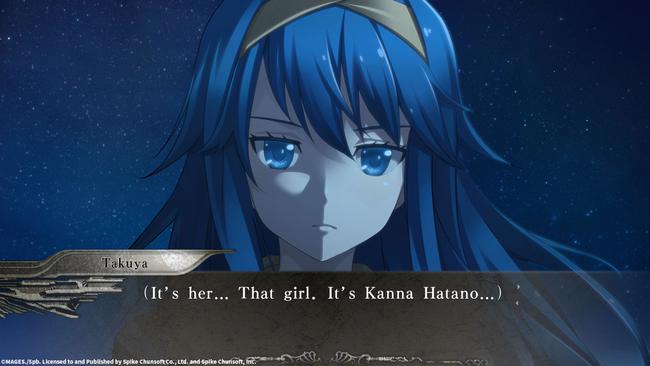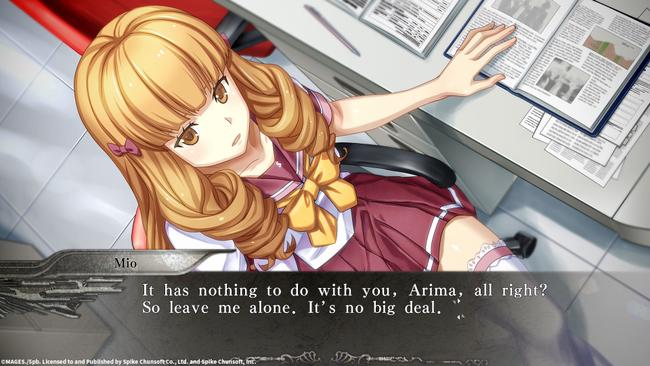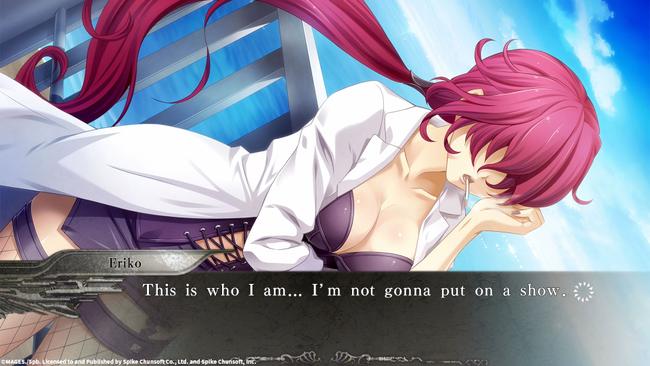YU-NO: A Girl Who Chants Love at the Bound of this World Review
YU-NO: A Girl Who Chants Love at the Bound of this World’s legacy is undeniable. When it released in 1996, it revolutionized the Visual Novel medium with its high production value, intricate plotline, and brilliant progression system. It was even one of the big inspirations for one of my favorite VNs ever made, Steins;Gate, so saying I was excited when YU-NO’s 2017 remake was announced for localization is an understatement. The remake was even developed by MAGES, creator of Steins;Gate (along with the rest of the Science Adventure games), and they are probably the best in the business when it comes to great user interface design in VNs.
It’s worth noting that the original version of YU-NO is an eroge at its core, with the remake being based on the Sega Saturn version which cut the sex scenes so it could be released on modern systems. Just because the actual scenes are not included in the remake however doesn’t mean they don’t happen in the context of the story, and doesn’t change the game’s tone. I bring this up to make it clear that knowing its history made me aware of what kind of game I was getting into from the beginning. Its just a shame that YU-NO exists as a case study of revolutionary works that don't stand the test of time.

Takuya Arima is a high school student and the son of a famous archeologist who has recently disappeared. He now lives only with his stepmother since his birth mother mysteriously passed away shortly after he was born. He lives his life now as a slacker, letting his grades suffer while he sorts out his complicated feelings towards his father. Things start simple and linear in the game’s prologue, until one day he discovers a package addressed to him by his dad which contains a mysterious device and a letter. The letter says that this Reflector device allows the user to travel freely between timelines, letting him stay in a single timeline for a limit of two days. There’s a lot more that goes into this, and the game even offers you an in-depth essay on how the science works for those who find value in that, but to avoid spoilers I’ll keep it at that. After an exciting incident at the end of the prologue, Takuya is thrown into a complicated trip through alternate timelines and dimensions in order to find the secret of what truly happened to his father.
What works well with this premise is that it feeds directly into the gameplay and story progression. YU-NO does not play out like a traditional VN, but more of a point and click adventure game. Every scene contains multiple parts of the environment to examine and hear Takuya’s snarky opinions about them, and there’s an emphasis placed on the places you go affecting how the game’s plot branches. There are still a plethora of dialogue choices to change how things play out too, which gives the game an open-ended sense of freedom in how you approach it. Progression is measured with A.D.M.S. (Auto Diverge Mapping System), a giant interactive flowchart that continuously expands with Takuya’s adventure. The only directions you’re really given are the vague locations on the flowchart for Jewels and Whirlpools. I’ll let you discover the secret behind Whirlpools yourselves if you chose to play, but you learn quickly that Jewels are an integral part of navigating A.D.M.S. efficiently.
Unlike flowcharts from games like Zero Escape or AI: The Somnium Files, the “nodes” which you are able to jump back to need to be set manually. That’s where Jewels come into play, letting you make Jewel Saves in A.D.M.S in addition to the traditional game saves you would normally expect. Jewel Saves seem annoying at first, but actually make the player think carefully about where they make their saves. This puts us in the shoes of Takuya, but for those worried about possibly being locked out of progression don’t worry. There’s an option to restart from the beginning of the flowchart while keeping your map progress and items, which can help players who find themselves stuck.
A.D.M.S. and the way it’s implemented into YU-NO’s point and click gameplay is simply genius. Navigating the multiple universes and gathering items from one to solve puzzles in another was beyond ahead of its time. This was the most fun I had in the entire game, and unraveling the plot is what kept me coming back for more. This remake even offers a hint system (which can be turned on and off in the menu) that will show people which locations to visit in order to branch the plot and what items to use at certain parts. This is useful because otherwise, I would have found it difficult to advance without the use of a guide.

I really only have two critiques of the gameplay, which are the tedium of skipping text as you catch back up after jumping back to previous events and the game’s cursor for the point and click segments. I can forgive text skipping for the most part, but this might make the experience drag for those not used to playing visual novels. The cursor itself works well, but how it works definitely took time to get used to. I have no idea if this is better in the PC port since I only played the console release, but it was very unconventional. The cursor locks into specific objects of each screen, with the analog stick freeing it up. What leads to occasional annoyance is that letting go before you reach a new object will snap the cursor immediately back to the object you were looking at. It made things a bit difficult to navigate at times, and I would have preferred a cursor that is free at all times while still highlighting the areas that you can click when you hover over them. Despite those gripes, it is imperative to mention that the gameplay of YU-NO is where it shines the most.
Which is why I found it so disappointing that everything else in the game paled in comparison. The story has a bunch of really interesting ideas with well-detailed science to back it up, but I didn’t care for the character routes or the execution of the plot. Like every eroge from the ’90s, the routes all focus on the game’s female cast. When Takuya isn’t complaining about everything, he’s spending his time in these routes solving the girls' problems. That, and engaging in sexual and/or romantic relationships with them. It’s easy to just call Takuya your typical hyper-horny eroge protagonist, but honestly, I would say he’s in a league of his own.
Your mileage may vary, but I found him to be obnoxiously rude and disrespectful. He sexually harasses the female cast frequently for next to no reason besides the fact that the game was written as an eroge. You may be quick to call me a prude for not liking him, but I do actually think there’s room for characters like this if they have any redeeming qualities. An effort was put into making his awful behavior slightly justified based on his relationship with his father, who acted similarly, but he learns nothing from this and is only rewarded for treating people like this. If there was a point to all of this, I would understand and be more willing to put up with this.
I love the use of flawed characters in visual novels, my favorite protagonist of all time is Takuru Miyashiro from Chaos;Child. There, the writers successfully uses his awful behavior and cowardice to make a point, giving him one of the best arcs I’ve ever seen. I understand that YU-NO is an eroge, but when you tout that the sex scenes and the plot are equal in footing, I expect a protagonist with a decent character arc. His development is minimal, and I feel this applies to the rest of the cast as well. The weak characters make going through the game a slog, and severely undermine any positive aspects of the story. There wasn’t anyone I ended up caring about, which is a big problem in a story centered around drama between characters.

If you’re expecting the game to be any less sexual since the remake cut all the sex scenes, then you might want to look elsewhere. Given that sex is an essential motivator for Takuya’s character, it’s woven into the plot in a way that you can’t really make it work without it. What you’re left with is a game that is full to the brim with constant innuendo and mentions of sex, that even keeps the build-up and aftermath of all the sex scenes intact. Every time a woman appears on screen, you can click just about every single part of their body to hear Takuya say something sexual about it. Adult games are not bad by any means, different strokes for different folks, but even with this context for Takuya’s character I still found him insufferable. I’m sure even the biggest eroge fans might find his behavior to grow tiring quick.
If you don’t care for excessive sexualization in your games, YU-NO will not be for you. It touches upon subject matter that you might find heavily uncomfortable, so I find it important to mention some of these. Four of the six main character routes feature Takuya sexually involved with grown women. There’s another big chunk of the game to happen after the main segment, but I’ll leave the secret to discovering that for you all. The important part of bringing this up however is to mention (in as few spoilers as possible) YU-NO’s fixation on incest. Eroge’s from this era often had a focus on this type of relationship, so I imagine this was par for the course for the '90s. There are three cases of parent-child incest that happen throughout the story of YU-NO, and two of these pop up in this second act. The other takes place in the first act with Takuya and his step-mother, which fans might debate me on counting as incest (a debate that I frankly don’t wish to participate in). At least this is better than the other two, which feel unnecessary and gross, but the route with her also happens to be the weakest in the game. The conflict of the route relies on misunderstanding and the characters refusing to be honest with each other. Its frustrations are cheap, and likely to make players stop altogether if they happen to stray onto this route first.
I get that sexualization is a very subjective criticism, but subpar translation quality is not. The YU-NO translation is readable at best, but frequently dips in quality leading to awkward dialogue that would occasionally leave me stumped at the meaning. I don’t think the people at Spike Chunsoft localized this themselves, because this falls far below their usual standards of quality. It seems this was more on the MAGES side, and it’s a shame that such an anticipated localization just doesn’t flow as well as it should. It needed another editing pass to clear up the numerous typos and sentence structure, but it sadly did not receive one. I do not speak Japanese so I can’t speak on the accuracy of the translation, but I can definitely speak on the stilted nature that plagues the entire experience.
To end on a slightly more positive note, I do find the presentation to be very solid overall. MAGES have delivered on their usual fantastic sound and visual design. I’ve been following their work since Chaos;Head, so I’ve been impressed with their evolution of both of these throughout the years. This remake offers two different soundtrack options, the original and one composed by Keishi Yonao. Both are very enjoyable, but I found the remade OST to be the one I stuck with since it simply modernizes what made the original soundtrack so catchy while still feeling right out of the '90s. This version also rerecorded all the voice acting, and I think it matches the standards set by MAGES. The visuals seem to be more divisive from fans of the original since it also modernizes the art direction.

All of the redrawn sprites and CGs are faithful to the framing of the original release, and while the art style is a bit generic (which I would honestly say about the original as well) it works fine enough. The art isn’t really what impressed me so much, but more that all the CGs go as far to have full mouth animations to have them transition better from shots with just the normal sprites talking. It would have been nice for the option to switch between the original art style and the new one for fans who wanted that, but I imagine the engine would have had issues with that. I know the Japanese PS4 release had a port of the Sega Saturn version included, but unfortunately Spike couldn’t acquire the rights to that. Even without that, I never had any issue with the new art being low quality. The backgrounds are worth bringing up too, as they’re exceptional in quality.
I wanted to love YU-NO, I truly did. It had a lot of great ideas, and for its time was undoubtedly impressive in revolutionizing visual novels as a medium. The problem with genre-defining works is that they sometimes don’t hold up as well as the games inspired by them. YU-NO had just as many glaring flaws in its story as it did innovative ideas, and this remake does nothing to fix or improve them. This was out of respect for the original author and I get that, but it is still a shame. For those who aren’t bothered by any of the issues I mentioned, you’ll probably appreciate the optional improvements to streamlining the gameplay. I would have loved the game more if it didn’t undermine such a brilliant and natural set of progression mechanics with a weak cast of characters and inconsistent plot.